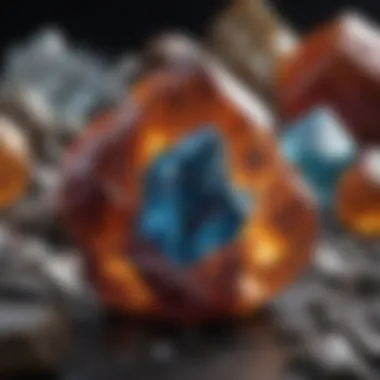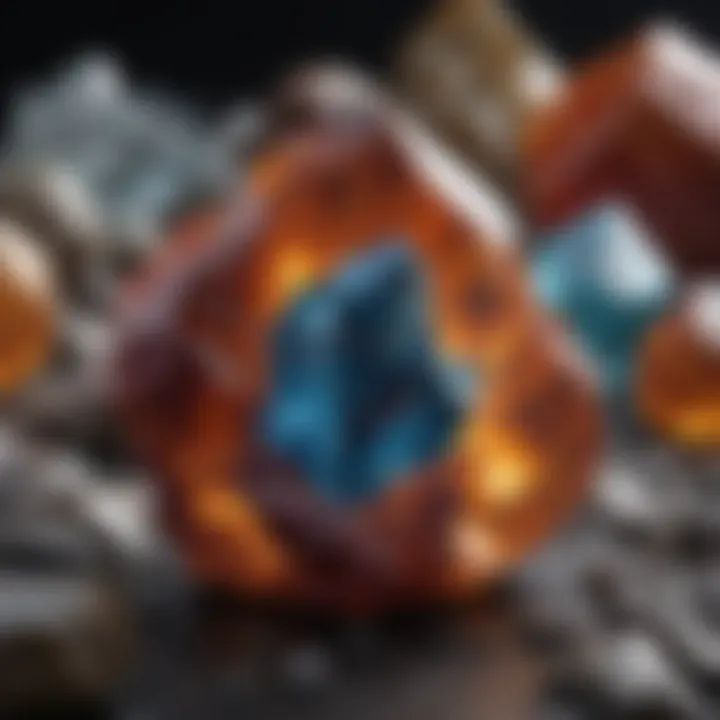Understanding Rocks and Crystals: A Detailed Guide


Intro
Rocks and crystals are more than mere geological specimens; they are key to understanding the Earth’s history. Each rock type embodies a story, from volcanic eruptions to coastal deposits. For collectors, enthusiasts, and educators, grasping these elements can enhance one’s appreciation for the natural world.
The aim of this article is to provide an in-depth look into the diverse types of rocks and crystals. It will cover their formation, classification, and significance. With this information, readers can delve deeper into geology and its relevance to everyday life.
History and Origins
Overview of Collectibles, Rocks, and Fossils
The interest in rocks and crystals spans centuries. From ancient civilizations that used stones as tools and ornaments to modern collectors seeking unique specimens, the enduring fascination is clear. Collectors often seek not just beauty but also the geological history encapsulated within these items.
Rocks are classified into three main types: igneous, sedimentary, and metamorphic. Each category holds a unique origin and distinct properties. Crystals, on the other hand, are classified based on their mineral content and internal structures. Both rocks and crystals offer insight into our planet's processes and transformations.
Historical Significance and Cultural Impact
Throughout history, rocks and crystals have held cultural significance. For example, ancient Egyptians valued lapis lazuli for its vibrant blue hue, linking it to royalty and the divine. Similarly, jade has been revered in Chinese culture as a symbol of purity and moral integrity.
The scientific study of rocks and crystals has evolved significantly. From early observations to modern geology, understanding these natural formations has helped us comprehend the Earth’s development. This evolution underscores the importance of rocks and crystals not just in scientific inquiry, but also in cultural practices.
"Rocks are the backbone of our planet. They tell the story of Earth’s journey over millions of years."
Identification and Classification
Guide to Identifying Rocks and Fossils
Identifying rocks and crystals can be an engaging process. It typically involves observing several characteristics:
- Color: The surface color can vary widely.
- Texture: This includes how the surface feels—smooth, rough, or granular.
- Hardness: Using the Mohs scale can help determine how easily the material can be scratched.
- Luster: This refers to how light reflects off the surface,
- Cleavage and Fracture: How the material breaks or splits can provide crucial identification clues.
Common Types and Variations
In the world of rocks and crystals, understanding the common types is essential. Igneous rocks, such as basalt and granite, are formed from cooled molten lava. Sedimentary rocks, like sandstone and limestone, arise from the accumulation of sediments. Metamorphic rocks, such as schist and gneiss, form under intense pressure and heat.
Crystal classification includes:
- Quartz: Known for its hardness and variety of colors.
- Calcite: Common in sedimentary rocks, known for its effervescence with acid.
- Amethyst: A popular purple variant of quartz.
By identifying these aspects, collectors can appreciate the diversity and significance of their specimens. This guide serves as a starting point for enthusiasts in their geological journey, fostering a deeper connection to the materials around them.
Prolusion to Rocks and Crystals
Rocks and crystals form the foundation of our planet's geology. Understanding these geological wonders can enrich one's appreciation for the earth's history and composition. This article thoroughly examines the types of rocks and crystals, providing critical insights into their formation, properties, and significance.
Defining Rocks and Crystals
Rocks are solid aggregates made up of one or more minerals. In other words, they are composed of small blocks of minerals packed together, often from various sources. Crystals, on the other hand, are solid substances where atoms are arranged in an ordered pattern. This specific arrangement gives crystals their distinctive structures and properties, setting them apart from amorphous materials like glass.
The distinction between rocks and crystals is essential for anyone studying geology or collecting specimens. Knowledge in this area allows collectors to categorize findings accurately, enhancing their understanding and appreciation of the specimens they encounter.
Significance in Natural History
Rocks and crystals tell us much about the Earth’s past. They record geological events over millions of years. For instance, sedimentary rocks can display layers that denote different periods of sediment deposition. By examining these layers, scientists can infer historical climates and environmental conditions.
Crystals also reveal crucial information. For example, the mineral composition of a crystal can indicate the conditions under which it formed. Collectors often search for unique crystals, as each specimen can provide insights into broader geological processes. According to expert geologists, these aspects make rocks and crystals invaluable to both researchers and enthusiasts.
"Every rock and crystal holds a story of our planet’s dynamic history. Understanding this can change how we view the natural world."
Types of Rocks
Understanding the different types of rocks is pivotal to appreciating the Earth’s geological processes. This section elucidates the three primary categories of rocks: igneous, sedimentary, and metamorphic. Each type reflects distinct formation processes, which contribute to various geological features and resources. Recognizing these differences fosters a deeper understanding of the natural world, essential for collectors and enthusiasts.
Igneous Rocks
Formation Process
Igneous rocks originate from the cooling and solidification of magma or lava. This process can happen either beneath the Earth's surface or on its surface, known as intrusive and extrusive formations, respectively. Intrusive igneous rocks form slowly underground and display coarse-grained textures due to the prolonged cooling time. In contrast, extrusive igneous rocks cool rapidly on the Earth's surface, resulting in fine-grained textures. This characteristic of the formation process makes igneous rocks critical for studying heat and pressure dynamics within Earth.
Major Types
The primary types of igneous rocks include granite, basalt, pumice, and obsidian. Granite is known for its light color and large grains, making it popular in construction. Basalt is darker and finer-grained, prevalent in oceanic crust. Pumice is recognized for its light weight, while obsidian is valued for its glass-like appearance. These types illustrate the broad range of igneous rock characteristics and their varied applications.
Examples
Noteworthy examples of igneous rocks include Mount St. Helens' basalt flows and the granite of Mount Rushmore. These examples underscore the geological significance of igneous formations and their visual appeal, making them popular among collectors. The unique textures and colors also influence the aesthetic value.
Sedimentary Rocks
Formation Process
Sedimentary rocks form through the accumulation, compaction, and cementation of sediments. Over time, layers of eroded material settle, with pressure from above compressing lower layers. This process signifies the geological timeline, as sedimentary layers often contain fossils. By analyzing these layers, we gain insights into Earth's history and environmental changes.
Major Types
The principal types of sedimentary rocks include sandstone, limestone, shale, and conglomerate. Sandstone, composed of sand-sized grains, often forms in desert environments. Limestone is primarily made of calcite from marine organisms. Shale, formed from clay, showcases fine layers, while conglomerate consists of larger, rounded particles. Each type has unique properties and implications for geology.
Examples
Examples include the Grand Canyon, which features extensive sandstone layers, and the famous limestone caves in Kentucky. These locations demonstrate the diverse environments where sedimentary rocks can be found. The fossil presence within these rocks provides valuable historical data, enriching our understanding of past life.
Metamorphic Rocks


Formation Process
Metamorphic rocks emerge from the alteration of existing rocks under heat, pressure, or chemical processes. This transformation can modify the original rock's texture, mineral composition, and structure. The specifics of formation result in distinctive characteristics, making metamorphic rocks fascinating subjects of study.
Major Types
Key types of metamorphic rocks include schist, gneiss, slate, and marble. Schist is characterized by its foliated texture, created under high pressure. Gneiss shows banding due to mineral segregation, while slate originates from shale and exhibits excellent cleavage. Marble, derived from limestone, is known for its aesthetic properties, widely used in art and architecture.
Examples
Famous examples include the schist found in the Swiss Alps and the luxurious marble sourced from Carrara, Italy. These examples highlight the importance of metamorphic rocks, both in understanding geological processes and in practical applications for architecture and design.
Classification of Rocks
The classification of rocks is a fundamental aspect of geology that helps in understanding their formation, evolution, and the processes that have shaped our planet. This system organizes rocks according to their attributes and provides insights into their origins. An understanding of rock classification is particularly beneficial for enthusiasts and collectors, as it allows them to identify and appreciate the diversity of geological materials they encounter.
Differentiating rocks into groups based on texture and chemical composition is essential in this narrative. This classification not only aids in the identification of samples but also reveals the history of geological processes. For those interested in collecting or studying rocks, knowing the classification is a baseline to start deeper explorations.
Textural Classification
Grain Size
Grain size is a critical factor in the textural classification of rocks. It refers to the diameter of the individual mineral or crystal particles found within a rock. This size can greatly influence the rock's appearance and characteristics. For instance, fine-grained rocks indicate rapid cooling, typically associated with volcanic activity, while coarse-grained rocks suggest slower cooling processes, often found in intrusions.
The key characteristic of grain size is its ability to reveal information about the environment of formation. Smaller grains may also enhance a rock's bonding capabilities, offering benefits during construction or landscaping.
However, the challenge with grain size is that variable conditions during formation may lead to misinterpretation. Overall, understanding grain size is beneficial for enthusiasts aiming to deepen their knowledge of geological history.
Porosity
Porosity refers to the volume of pores or voids within a rock. This characteristic is essential as it affects the rock's ability to hold water or other fluids. So, rocks with high porosity are often of interest in fields like hydrogeology and petroleum engineering. For collectors, understanding porosity can enhance the appreciation of how a rock interacts with its environment.
The key feature of porosity is its ability to either enhance or impair fluid transport. High porosity can indicate a rock is excellent for aquifers, while low porosity suggests limited fluid movement, which is relevant in various applications.
Despite its advantages, porosity may lead to weaknesses in a rock, as more voids could reduce overall strength. Therefore, the knowledge of porosity contributes to a fuller understanding of rock behavior and applications.
Structure
Structure in this context pertains to the arrangement of the grains within the rock. This arrangement can indicate the processes that formed the rock and can reflect tectonic activity or sedimentation patterns. An understanding of rock structure provides insights into the geological forces at play during its formation.
The unique aspect of structure is its complexity; it can involve layering, folding, or absence of order. This complexity is often what entices collectors and explorers. Collecting structurally interesting specimens can offer insights into the geological past.
However, assessing structure can be challenging. Different geological forces can create similar structures, making identification complicated. Still, structure remains a valuable consideration for anyone interested in geology and will enhance their capabilities in understanding the historical context associated with various rocks.
Chemical Composition
Mineral Content
Mineral content is a key part of the classification of rocks and refers to the minerals that constitute the rock. The presence and composition of minerals give each rock its distinctive character. For collectors, knowing the mineral content is paramount as it can influence both the appearance and hardness of the rock.
The significant feature of mineral content is its variation; different combinations result in diverse rock types and appearances. This attribute is beneficial for identifying rocks and for evaluating their use in various applications, from construction to jewelry.
However, challenges arise when differentiating between minerals that appear similar. Accurate identification often requires specific knowledge or equipment, highlighting the importance of education in this aspect.
Elemental Analysis
Elemental analysis involves examining the elemental composition of rocks. This method reveals the proportions of elements present in a sample. Such analysis is instrumental in identifying the origin and possible alterations a rock has undergone over time.
The key characteristic of elemental analysis is its precision; it offers detailed information that can confirm a rock type or its historical transformation. This is particularly useful for collectors who may seek specific types for their collections.
While elemental analysis provides valuable insights, the complexity of the analysis itself can pose challenges. Equipment required may not be readily available for casual collectors. Nonetheless, understanding elemental analysis fosters a deeper connection with the science behind rocks and minerals, enriching the knowledge base of any enthusiast.
Types of Crystals
Understanding the types of crystals is essential for anyone interested in the diverse world of geology and mineralogy. This section illuminates the classification of minerals, focusing on their specific subgroups. Each category provides valuable insights into the characteristics and significance of these formations. By exploring silicates, carbonates, and oxides, we gain a deeper appreciation for their roles in nature and the applications in various fields.
Minerals and Their Classification
Silicates
Silicates constitute the largest and most complex group of minerals in the Earth's crust. They are made up of silica tetrahedra, which are basic building blocks. The arrangement of these tetrahedra results in various silicate structures, which contribute to the properties of these minerals. This complexity highlights their importance in both geological and industrial contexts.
The key characteristic of silicates is their diverse formation. They can form under a wide range of conditions, leading to a variety of mineral types. Common examples include quartz and feldspar, which are widely used in building materials, ceramics, and electronics. The unique feature of silicates is their ability to undergo metamorphism, altering their structural properties under heat and pressure. This metamorphism offers various textures and colors, making silicates popular among collectors. However, their abundance might lead to challenges in distinguishing between similar types.
Carbonates
Carbonates are another significant group of minerals, primarily composed of carbonate ions. They play an essential role in the carbon cycle and are crucial for many geological processes. A well-known characteristic of carbonates is their reaction to acids, which can help in their identification. Common examples include calcite and dolomite, utilized in construction and manufacturing.
The unique feature of carbonates is their formation from biological processes. Many carbonate minerals originated from the accumulation of skeletal remains of marine organisms. This adds an intriguing narrative to their geological history. However, carbonates can also be sensitive to environmental conditions, which impacts their preservation and display, particularly in collections.
Oxides
Oxides are minerals made from oxygen combined with metal or non-metal elements. They are significant components of the Earth's crust and are used in various applications, from metallurgy to electronics. A key characteristic of oxides is their widespread occurrence in geologic settings, often associated with igneous and metamorphic rocks.
The unique feature of oxides lies in their varied properties, which depend on the constituents. For instance, hematite is an important iron ore, while corundum is a source of aluminum and forms rubies and sapphires. The diversity in color and crystalline forms of oxides makes them a popular choice for collectors. On the downside, identifying oxides can be complex due to similar appearances among different types.
Crystallography Basics
Crystallography is the scientific study of crystals and their structures. It is fundamental for understanding the physical characteristics of minerals. By studying crystallography, we can identify crystal forms and symmetry, influencing how these materials interact with light and other substances.
Crystal System
The crystal system classifies crystals based on their geometric arrangement. There are seven primary systems, including cubic and hexagonal, each exhibiting distinct symmetry and properties. This classification is beneficial for mineral identification and is vital when studying crystal growth and properties.


The unique feature of crystal systems is their ability to categorize extensive mineral varieties based on shared characteristics. This structured approach eases the learning process for enthusiasts and collectors alike. However, the complexity of certain systems can pose challenges for newcomers.
Lattice Structure
Lattice structures describe the three-dimensional arrangement of particles within a crystal. This arrangement influences the physical properties, such as hardness and cleavage. By understanding lattice structures, one can predict how a crystal will behave under various conditions.
The unique advantage of lattice structure analysis is the explanation it provides for the observable characteristics of minerals. For example, the lattice symmetry can affect a crystal's optical properties, such as polarization. However, studying lattice structures requires a basic understanding of advanced concepts, which may be intimidating for beginners.
Crystals and Their Properties
Crystals are not just visually appealing; they hold significant importance in various scientific domains. Understanding their properties offers insights into their formation, classification, and uses. Physical and optical properties make up the core aspects of crystals, revealing much about their nature and applications.
Physical Properties
Physical properties refer to how crystals behave under different conditions. Three important aspects to consider are hardness, luster, and cleavage.
Hardness
Hardness is a measure of a crystal's resistance to scratching, which determines its durability. This property is crucial for collectors, as it reflects how well a crystal can withstand wear over time. The Mohs scale of mineral hardness classifies minerals from 1 (talc) to 10 (diamond), which provides a useful comparison.
The key characteristic of hardness is its ability to indicate a crystal's potential use. Harder crystals are often more sought after, making them not only attractive for collections but also for industrial applications. However, harder minerals can be less common, which may raise their value among collectors.
The unique feature of hardness can be observed in how different minerals respond to external forces. For instance, quartz has a hardness of 7, making it suitable for various practical applications. On the other hand, softer minerals like gypsum, with a hardness of 2, may require more careful handling.
Luster
Luster describes how light interacts with a crystal's surface. This property greatly influences the aesthetic appeal of crystals, as it contributes to their visual characteristics. Luster can be categorized as metallic, glassy, pearly, or dull, among others.
The key characteristic of luster is its ability to enhance a crystal's attractiveness. Crystals with a glassy finish, such as quartz, are particularly popular. The shiny appearance catches the eye and invites collectors to seek them out.
A unique aspect of luster is how it can also hint at the mineral's composition. For example, a metallic luster can indicate the presence of heavy metals like lead or iron. However, it may also make identification a bit tricky, as some non-metallic minerals can also appear shiny under certain lighting.
Cleavage
Cleavage refers to how a crystal breaks along specific planes of weakness. This property reveals how the internal structure of a mineral defines its behavior during stress. Understanding cleavage is crucial for identifying and classifying crystals.
The key characteristic of cleavage is that it can indicate the crystal's symmetry and structure. Minerals such as mica exhibit perfect cleavage, allowing them to be split into thin flakes. This is beneficial for applications like insulation or decorative finishes.
The unique feature of cleavage may also play a role in determining a crystal's resilience. Crystals with poor cleavage might be tougher and more suitable for everyday uses. However, this can make them less visually appealing, as clean breaks are often desired for collectors.
Optical Properties
Optical properties govern how crystals interact with light. They include refraction and birefringence, both significant for practical uses and aesthetics.
Refraction
Refraction occurs when light passes through a crystal and bends due to a change in speed. This property is essential for understanding how light behaves when it encounters different substances.
The key characteristic of refraction is its ability to enhance the visual effect of a crystal. Higher refractive indices often result in more brilliant reflections and sparkle. This is one reason why gemstones like diamonds, with high refraction, are so prized.
A unique aspect of refraction is how it can also help in identification. By measuring the angle of deviation, one may determine the material’s refractive index, aiding in sorting different types of crystals.
Birefringence
Birefringence refers to a crystal’s ability to split light into two distinct beams. This property results from the crystal's internal structure and composition. Birefringence is especially important in the field of optics.
The key characteristic of birefringence is its contribution to the visual effects and properties of crystals, particularly in polarized light environments. Crystals like calcite exhibit strong birefringence, making them a focus for optical studies.
A unique feature of birefringence is that it may aid in the identification process. By analyzing how a crystal behaves under polarized light, collectos can differentiate between mineral varieties more accurately.
Understanding the properties of crystals is a gateway to appreciation and practical use in various fields, from geology to industrial applications.
Identifying Rocks and Crystals
Identifying rocks and crystals is a fundamental aspect for enthusiasts and collectors. The process aids in understanding geological traits and enhances proper classification. Accurate identification serves several purposes: it informs collectors about the origin, increases knowledge about mineral composition, and enriches one's appreciation of nature's artistry. Accurate identification directly impacts collection value, knowledge gain, and conservation efforts.
Field Identification Techniques
Visual Assessment
Visual assessment plays a crucial role in identifying rocks and crystals. This method involves examining the physical appearance of specimens, which can reveal a wealth of information. The key characteristic of visual assessment is that it requires no special equipment; simple observation suffices. This makes it accessible and beneficial for fieldwork.
Unique features of visual assessment include observable attributes such as color, texture, and crystalline structure. However, it has limitations, as some similar-looking minerals can be easily confused. This might lead to misidentification, especially if one relies solely on visual cues without supplementary methods.
Physical Tests
Physical tests provide additional verification in the identification of rocks and crystals. These tests evaluate properties like hardness, magnetism, or streak, offering a more quantifiable approach beyond what is visible. The main characteristic of physical tests is their practicality, allowing collectors to compare hand specimens directly.
Unique features involve straightforward procedures, often yielding fast results. Still, physical tests can require tools like a hardness kit or glass streak plate. The advantage lies in their ability to deliver accurate and immediate data, yet some tests can be intrusive or damaging to the specimen, requiring careful consideration when undertaken.
Laboratory Analysis
Laboratory methods deepen the identification process, providing comprehensive chemical and structural analysis. These techniques can confirm visual or physical assessments and are valuable for detailed studies. Microscopy and spectroscopy are two primary methods used.
Microscopy
Microscopy allows for detailed observation of rock and crystal structures at a microscopic level. Its key characteristic lies in revealing internal features like crystal habits or inclusions. Such insights are invaluable for precise identification, making microscopy a well-regarded technique in geological and mineralogical studies.
The unique feature of microscopy is its capability to highlight details invisible to the naked eye. However, successful use requires specific training and equipment, which may not be accessible to all collectors. Despite this, the depth of knowledge gained often outweighs the drawbacks of cost and complexity.
Spectroscopy
Spectroscopy, another powerful analytical technique, assists in determining the elemental composition of samples. Its significant characteristic is its ability to identify minerals based on their unique spectral signatures. This makes spectroscopy an exceptionally beneficial choice, particularly in distinguishing complex mineral mixtures.


The process's unique feature is its non-destructive nature, preserving the integrity of the specimens analyzed. Still, equipment can be costly, and interpreting spectra can require experience. Overall, spectroscopy enhances understanding and identification of materials on a molecular level, integrating well into any thorough geological investigation.
Key Takeaway: Understanding identification methods enhances knowledge about rocks and crystals significantly. Field techniques give immediate feedback, while laboratory analysis ensures accuracy and depth.
Collecting and Preserving Rocks and Crystals
The practice of collecting rocks and crystals is more than a mere hobby; it is an exploration into Earth's history and mineral diversity. Collecting and preserving these specimens represents a tangible connection to nature, allowing collectors to witness the beauty and complexity of geological processes over time. Proper collecting methods and preservation techniques are critical for maintaining the integrity and aesthetic quality of the specimens.
Ethical Collecting Practices
Legal Considerations
Understanding the legal implications of rock collecting is essential. Many regions have specific laws governing the collection of rocks and crystals. These laws aim to protect natural resources and preserve geological heritage. For example, collecting in national parks or protected areas is often illegal without a permit. Thus, knowing local regulations helps ensure that collectors do not unwittingly engage in unlawful practices.
Complying with legal considerations promotes responsible stewardship of the environment. It reflects a commitment to preserving ecosystems for future generations. Those who follow legal guidelines also enhance their reputation in the collecting community.
Sustainable Practices
Sustainable practices in rock collecting focus on minimizing ecological impact. This involves being mindful of the environment when collecting, such as taking only what is allowed and leaving habitats undisturbed. Collectors should use non-invasive methods to extract samples. Being aware of the environmental significance of collecting sites is vital. Some locations may have unique ecosystems that can be harmed by overharvesting.
Incorporating sustainability not only preserves natural habitats but enriches the collecting experience. Collectors engaging in sustainable practices often discover a deeper respect for the natural world and its delicate balance.
Care and Maintenance
Effective care and maintenance are critical to ensure that collected rocks and crystals remain in pristine condition. This task involves proper storage and regular cleaning to avoid damage and degradation over time.
Storage Solutions
Proper storage solutions can greatly affect the longevity of rocks and crystals. Ideally, collectors should store specimens in a cool, dry place away from direct sunlight. Using display cases or padded containers can prevent physical damage. Specially designed storage solutions help keep specimens organized and protected from moisture and dust, which can cause deterioration.
A well-maintained storage system can also enhance the aesthetic presentation of a collection. Thus, collectors often find joy in displaying their specimens beautifully while ensuring their safety.
Cleaning Techniques
Cleaning techniques are another vital aspect of maintenance. Dust accumulation can dull the natural luster of crystals and rocks. Simple methods, like using a soft brush or damp cloth, can effectively remove dirt without harming the specimens. However, caution is important. Some rocks and crystals may require gentle cleaning solutions or even professional restoration.
Regular cleaning maintains the visual appeal of a collection. Moreover, understanding the specific needs of various minerals can prevent potential damage. Thus, having knowledge of proper cleaning techniques greatly benefits collectors.
The Role of Rocks and Crystals in Culture
The significance of rocks and crystals stretches beyond their physical forms. Throughout human history, they have held cultural value. Their roles in art, religion, and science enrich our understanding of civilizations. An exploration of their historical significance reveals deep connections with humanity.
Historical Significance
Cultural Artifacts
Cultural artifacts made from rocks and crystals showcase the creativity of societies. These items often represent beliefs, technologies, or artistry of a given time. For example, ancient tools made of flint or obsidian are not just practical; they signify the innovative spirit of our ancestors. Artisans carved decorative items from semi-precious stones, reflecting cultural identity.
The craftsmanship of cultural artifacts often involves high skill levels. Their design can tell stories or highlight important figures in history. Several museums worldwide display examples of these items, enriching our narrative on human development. Their aesthetic and functional properties make them beneficial for educational purposes. However, not all artifacts are well-preserved, presenting a challenge to this narrative.
Mythology and Folklore
Mythology and folklore imbue rocks and crystals with meaning that can last generations. Different cultures have ascribed various powers to these geological materials. For instance, many beliefs center around healing properties attributed to specific crystals. Stories of deities and mythical creatures often associate various minerals with spiritual significance.
The lore surrounding rocks constructs a bridge between material and immaterial cultures. It serves as a testament to how societies have mediated their relationships with the natural world. However, the interpretation of these legends can vary greatly, sometimes leading to misunderstandings about their original context. This variability may both enrich and complicate their study.
Modern Applications
Modern times have seen a renaissance in the interest in rocks and crystals. Their uses have evolved, leading to new applications.
Gemstone Industry
The gemstone industry represents a fusion of natural beauty and economic influence. Diamonds, rubies, and sapphires are highly valued for their beauty. They play crucial roles in jewelry, and their market continues to thrive worldwide. Their rarity and aesthetic qualities have made them symbols of status and wealth.
The industry also brings ethical challenges. Questions about the origins of certain gemstones have surfaced. This concerns impact on communities from where stones are extracted. As awareness grows, there is a push for ethical policies in sourcing these materials. Such considerations are vital for ensuring sustainable and responsible practices within the market.
Technological Uses
Beyond aesthetics, rocks and crystals have practical applications in technology. Specifically, quartz crystals are essential in devices like smartphones and computers. Their ability to convert electricity into mechanical energy makes them suitable for various electronic applications.
In addition, many minerals feature prominently in manufacturing batteries and solar panels. This versatility presents advantages in modern technology, particularly in renewable energy sectors. However, sourcing these minerals raises environmental concerns that must be addressed.
By understanding both role historic and present uses of rocks and crystals, collectors can appreciate their wider impact on society. The combination of cultural history and modern science gives these geological formations intrinsic value that extends far beyond their physical appearance.
Ending
The conclusion of this article is a critical component that encapsulates the essence of the discussion on rocks and crystals. It serves to reiterate the various types and their significance, both from a scientific perspective and in the realms of culture and collection. Understanding the differences between igneous, sedimentary, and metamorphic rocks is not just an academic exercise but a gateway to appreciating the natural world. Rocks and crystals are foundational elements of Earth’s history, each telling a story of formation, transformation, and existence over millions of years.
Summarizing Key Points
In this retrospective analysis, the article has covered extensive topics:
- Types of Rocks: Explored the distinct processes involved in the formation of igneous, sedimentary, and metamorphic rocks. Each type plays a unique role in our planet’s geology.
- Types of Crystals: Provided insights into mineral classifications and their crystallography, explaining how their properties allow us to categorize them further.
- Properties of Rocks and Crystals: Key characteristics such as hardness, luster, and chemical composition were outlined, allowing for better identification and appreciation.
- Identifying Techniques: Discussed field methods and laboratory analyses that aid in the precise cataloging of specimens, which enhances the collector's journey.
- Cultural Impact: Noted the historical significance and modern applications of rocks and crystals, emphasizing their enduring relevance.
These points create a comprehensive understanding that elevates the reader’s knowledge and appreciation of geological specimens.
Future Exploration
Continued Learning
Continuous education is a vital aspect of engaging deeper with the world of rocks and crystals. It contributes directly to the overall goal of enriching knowledge and understanding of geological sciences. One of the most vital characteristics of continued learning is its adaptability; it accommodates diverse learning styles, benefiting enthusiasts of various backgrounds. This adaptability allows for ongoing skill enhancement, from fundamental knowledge to advanced scientific inquiry.
Unique features of continued learning include access to resources like workshops, online courses, and textbooks. Each offers different advantages, such as personal interaction with experts or the flexibility of self-paced learning, catering to individual preferences. However, the potential downside can include the vast amount of information that may overwhelm newcomers. Nonetheless, a structured approach to learning ensures a solid foundation and informed engagement with this fascinating field.
Community Engagement
Engaging with a community enhances the experience of collecting and studying rocks and crystals. Community engagement fosters a supportive environment that shares expertise, experience, and enthusiasm. One key characteristic of community engagement is collaborative learning; it encourages members to share insights and techniques, ultimately enriching collective knowledge. Such an environment is beneficial as it builds relationships among collectors, creating a network of support and learning.
The unique features of community engagement can include local clubs, online forums, and social media groups. These platforms allow enthusiasts to connect over common interests and share discoveries. The advantages of active participation include immediate access to diverse perspectives and resources. Conversely, a potential disadvantage could be the risk of misinformation, which highlights the importance of critical analysis and peer-reviewed sources in discussions. Thus, engaging with trusted communities or networks can greatly amplify the learning journey while minimizing risks.



